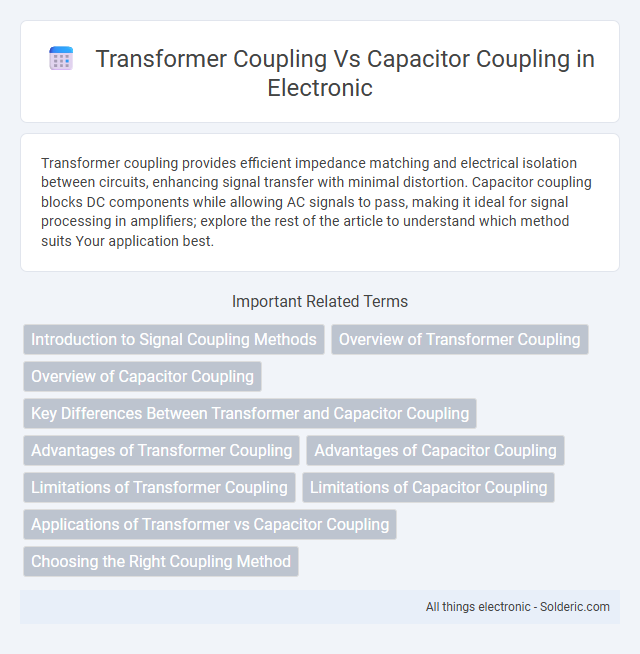Transformer coupling provides efficient impedance matching and electrical isolation between circuits, enhancing signal transfer with minimal distortion. Capacitor coupling blocks DC components while allowing AC signals to pass, making it ideal for signal processing in amplifiers; explore the rest of the article to understand which method suits Your application best.
Comparison Table
| Feature | Transformer Coupling | Capacitor Coupling |
|---|---|---|
| Purpose | Transfers electrical energy using magnetic induction | Transfers AC signals, blocks DC components |
| Frequency Range | Wide (audio to RF) | Medium to high frequencies |
| Impedance Matching | Excellent; can match different impedances | Poor; dependent on capacitor reactance |
| Size | Bulky due to magnetic core | Compact and lightweight |
| Power Handling | High power capacity | Limited power handling |
| Signal Distortion | Minimal distortion | Possible at low frequencies |
| DC Isolation | Provides DC isolation | Blocks DC by default |
| Cost | Higher due to complexity | Lower, simpler components |
| Applications | Audio amplifiers, RF circuits, impedance matching | Amplifier coupling, signal filtering, blocking DC |
Introduction to Signal Coupling Methods
Signal coupling methods are essential in electronic circuits for transferring signals between stages while isolating DC components. Transformer coupling leverages magnetic induction to achieve galvanic isolation and impedance matching, making it ideal for power transfer and audio frequency applications. Capacitor coupling uses capacitive reactance to block DC voltages and pass AC signals, commonly employed in amplifier stages to separate biasing conditions without signal distortion.
Overview of Transformer Coupling
Transformer coupling involves the transfer of electrical energy between circuits through magnetic induction using a transformer, enabling impedance matching and galvanic isolation while maintaining signal integrity across varying frequencies. It is widely used in audio and radio frequency applications to provide voltage transformation and isolate circuit sections. The magnetic core and winding configuration determine the efficiency and frequency response of the transformer coupling system.
Overview of Capacitor Coupling
Capacitor coupling uses a capacitor to connect two circuits, allowing AC signals to pass while blocking DC components, which prevents DC bias from affecting subsequent stages. This method is common in audio and signal processing applications, offering simple isolation and frequency-dependent filtering based on capacitor values. In contrast to transformer coupling, capacitor coupling is more compact, cost-effective, and ideal for high-frequency signal transmission without the bulk of magnetic components.
Key Differences Between Transformer and Capacitor Coupling
Transformer coupling uses electromagnetic induction between coils to transfer energy, providing voltage transformation and isolation, while capacitor coupling relies on capacitive reactance to pass AC signals and block DC components. The transformer coupling offers impedance matching and galvanic isolation, making it ideal for power applications, whereas capacitor coupling is simpler, with frequency-dependent reactance suited for signal coupling in amplifiers. You should select transformer coupling when isolation or voltage scaling is required, and capacitor coupling when only signal transfer with DC blocking is needed.
Advantages of Transformer Coupling
Transformer coupling offers superior impedance matching, enabling efficient power transfer between different circuit stages, especially in audio and RF applications. It provides galvanic isolation, enhancing safety and reducing noise interference in sensitive equipment. Your system benefits from voltage step-up or step-down capabilities, allowing for greater design flexibility and improved signal integrity compared to capacitor coupling.
Advantages of Capacitor Coupling
Capacitor coupling offers superior frequency response by effectively blocking DC components while allowing AC signals to pass, making it ideal for high-frequency applications. It provides simpler circuit design and reduced size compared to transformer coupling, resulting in lower cost and increased reliability. Capacitor coupling also eliminates issues like core saturation and magnetic losses, enhancing overall signal integrity.
Limitations of Transformer Coupling
Transformer coupling faces limitations such as size and weight constraints, frequency response restrictions, and core saturation at high power levels. Its performance degrades at very low frequencies due to the inductance of the transformer windings, and high-frequency signals can be distorted by parasitic capacitances. You may find capacitor coupling more suitable for applications requiring compact design and wider bandwidth without the drawbacks of magnetic core saturation.
Limitations of Capacitor Coupling
Capacitor coupling faces limitations such as signal loss at low frequencies due to the inherent reactance of capacitors, which can distort or attenuate bass signals. It also introduces phase shift and can cause signal degradation in high-power applications because of dielectric losses and voltage breakdown risks. Your system may require transformer coupling when isolation, impedance matching, or handling wide frequency ranges without significant distortion is essential.
Applications of Transformer vs Capacitor Coupling
Transformer coupling finds extensive applications in impedance matching, isolation, and signal amplification within audio systems, radio transmitters, and power supplies. Capacitor coupling is predominantly used for blocking DC components while allowing AC signals to pass, making it ideal for audio frequency circuits, amplifiers, and filtering applications. Both methods are essential in different scenarios: transformers excel in power transfer and isolation, whereas capacitors are preferred for signal coupling and noise reduction.
Choosing the Right Coupling Method
Transformer coupling provides galvanic isolation and impedance matching, making it ideal for audio and RF applications where signal integrity and noise reduction are critical. Capacitor coupling allows DC blocking while passing AC signals, commonly used in amplifier stages for its simplicity and low cost. Selecting the appropriate coupling method depends on factors such as frequency range, impedance requirements, power handling, and the need for isolation or noise immunity.
Transformer coupling vs Capacitor coupling Infographic

 solderic.com
solderic.com